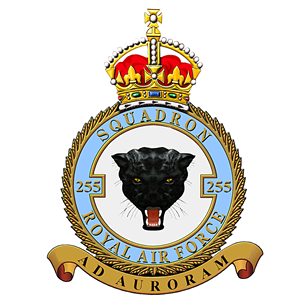Last updated: 20 August 2016, 17:45
Ad Auroram
To the Break of Dawn
 |
The Squadron Crest remains © Crown Copyright in perpetuity
Reproduced here with the consent of the MoD Intellectual Property Office |
Origins
There is no known record of the squadron having either a badge or a motto during World War One, and the unit did not immediately acquire these during World War Two either.
The earliest surviving record of a provisional badge design is in a letter dated 12 August 1942 sent by John Dunamace Heaton-Armstrong, MVO, Chester Herald and Inspector of Royal Air Force Badges, addressed to an Air Ministry administrator, Wing Commander V. Gibbs DSC. That correspondence proposes both the Panther’s Face (as an image appropriate to a night prowler) and the Motto
Ad Auroram (Latin: To the Break of Dawn).
[1]
The final approval of His Majesty the King was notified to Eastern Air Command on 7 January 1943, the squadron by then being in North Africa.
[2]
The years 1943–1946
At this point in time, the historical record diverges. File AIR2/6466 at The National Archives would have the reader believe that the "Royal painting" (the copy of the artwork personally signed by the Monarch) remained with the College of Arms for the duration of hostilities and was stored in Berkeley Castle. That is not necessarily so; the Air Ministry records contained in TNA’s file have, at some time in the past, been weeded in a way that obscures the true outcome. The records of Garter King of Arms contain additional documents showing that custody of the Royal painting was requested by the Squadron and that the request for possession was granted. What isn’t clear from either set of records is where the Royal painting went in the years 1943–1946. On tour around the Mediterranean, perhaps? That mystery remains unsolved.
Corruption of the design
In the years following the disbanding of the squadron, and particularly with the advent of the Internet, the strict form of the panther’s face as defined by the Royal painting was too often replaced by a more stylised Heraldic panther, grey rather than black in colour with just three whiskers and a red mouth rather than pink. That is incorrect, even though it tallies with the somewhat abbreviated blazon originally set down in 1942/43 which simply read "A Panther’s face". The fullest Heraldic description might be "On a field Argent, a Panther’s head cabossed Sable eyed and tongued proper". However, it is conventional when setting down the blazon for RAF badges to omit at least the Field (because almost all are the same).
Correspondence with Garter gives rise to the following compromise: "A Panther’s face Sable eyed and tongued proper".
[3]
Sable being the heraldic term for black, the panther should therefore have black fur, a pink tongue and yellow/gold eyes – "proper" being the heraldic term specifying natural rather than conventional colour.
The crest today
When the Squadron was disbanded in April 1946 the treasured artwork somehow found its way to the Air Historical Branch of the RAF, who remain the custodians to this day (2014). Originally based at Bentley Priory, near Stanmore, following the closure of that site the AHB moved to RAF Northolt.
A depiction of the whole Crest is to be found, carved (appropriately enough) in Welsh Slate, set into the floor of the centre aisle of St.Clement Danes Church in London.
In memory of all those who served in 255, Shaun Stewart (son of the late C.L.W.Stewart) sponsored the creation of a copy of the badge on goatskin parchment. Researched and carried out by the
RAF Heraldry Trust, this now resides in the RAF Cranwell archives.
Why no Standard or Battle Honours?
In order to qualify for a Standard, a squadron normally has to have existed on aggregate for 25 years. That's not so in the case of 255. The exception is if the squadron did something really special, which is how No.617 Squadron, The Dam Busters, got theirs ahead of time.
Having a Standard and displaying Battle Honours are interlinked, the only
specified place for display of Battle Honours being on the Standard. However, display elsewhere is not prohibited. That raises the question of qualification – not a simple matter because the definitions are complex. For example, Salerno can only be claimed if the enemy was engaged within the one-week time period 09 to 16 September 1943. A provisional list for 255 seems to comprise:
Home Waters 1914-1918
Home Defence 1940-1945
North Africa 1942-1943
Mediterranean 1940-1943
Sicily 1943
Salerno
Italy 1943-1945
Gustav Line
South-East Europe 1942-1945
Gothic Line
...a formidable list amassed in less than 57 months of wartime service.
[4]
Citations and Footnotes
Click on the ^ symbol to return to the text you were reading.
Copyright © 2014–2026. All rights reserved except where otherwise stated.

